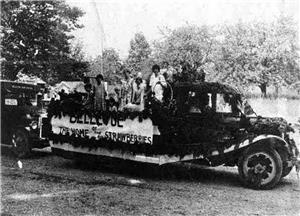In mid-June 1925, the first annual Bellevue Strawberry Festival is held behind the Main Street school. It becomes an annual three-day festival until 1942, when all of the Japanese strawberry farmers are relocated to internment camps following the onset of World War II. The Bellevue Historical Society will revive the festival in 1987.
A Berry Good Time
By the 1920s, Bellevue had become well-known for its tasty strawberries, a chief crop of many families, mostly Japanese. One night in 1925, Mrs. Charles Bovee had a dream about a celebration featuring the strawberry harvest. She told her husband Charles, a local realtor and later Bellevue's first mayor, who thought it was a great idea. A committee was formed, and $40 was raised to pay for the first festival, which attracted 3,000 visitors.
Word spread, and over the years more and more people came to nosh on yummy shortcakes drenched in strawberries and cream, while watching skits and acts performed on stage. Car caravans would travel from nearby cities, including Kirkland, as a show of neighborly support.
One year a group of Kirkland businessmen staged a mock revival meeting, wherein a "faith healer" brought out the best in people. A person on crutches approached the stage and was "healed." He performed a short dance to the enjoyment of all. Another poor soul, who had been struck dumb, burst forth into beautiful song. Lastly, a sorrowful man came up on stage sporting a very large tumor on his side. It was cut open to reveal a fiddle, which the now healthy man played joyously with reckless abandon.
Gone, but not Forgotten
In 1935, more than 15,000 people attended the festival -- nearly five times the number of people that lived in the small town. The three-day event continued to be held annually until 1942, the year that 55 local Japanese families were forced to go to internment camps. Most of Bellevue's strawberries at that time were grown by Japanese farmers, who together managed 472 acres of land.
When the war ended, very few of these Japanese families returned. At the same time, much of the farmland had become too valuable for growing berries, and was used instead for home and business construction.
In 1987, the Bellevue Historical Society revived the Strawberry Festival to honor the city's past. Since then, it has once again become an annual tradition, enjoyed by many from all walks of life.

